Losing weight. Eating healthy. Not just empty words. For a lot of men 50 and over it can be a daily struggle. Add in schedules driven by work, travel, family, or just over-active lifestyles, those well-intended goals can easily slip farther out of reach. It’s reasonable to look for a quick fix, something promising everything you need in a neatly packaged meal or plan. And of course, there’s no shortage of materials, from books, articles, medical services to outlandish diet plans. The topics in this series we’ll cover are the top four fad diets making the marketing rounds; the Keto Diet, the Paleo Diet, Intermittent Fasting, and Carb Cycling.
The thing you need to know about fad diets is they rely on eliminating or reducing entire food groups, such as fats or carbohydrates. Or they may be based entirely on consuming large amounts of one type of food, (think: grapefruit diet, watermelon diet, etc.) depriving your body of necessary nutrients. This could send your metabolism or energy into a tailspin or make your body protect fat stores because it thinks it’s starving. So for your health’s sake, anytime you embark on a change to diet or exercise, please consult your doctor!
KETO DIET
The keto diet is a high fat, moderate protein, low carb eating approach, typically broken down to 75, 20, and 5 percent of your daily calories, respectively. After you follow the diet for a few days, your body enters a state called ketosis, which means it’s started to use fat for energy instead of carbohydrates.
What can you eat on the Keto Diet
Keto is low-carb, so red meats, poultry, pork and seafood are a definite. Green, leafy vegetables (spinach, greens, lettuce, beans, etc.) are preferred over “starch” vegetables like corn, potatoes, or yams. Same for fruits, watch for starch and measure the carbohydrate levels carefully.
You can have certain dairy with keto if you’re not lactose intolerant, so butter, cheeses and yogurts are good, (no milk) but you must watch the sugar content.
Within your caloric goals, fats from plant and nut oils are ok, just be wary of processed oils and always watch for trans fats.
Benefits/Expectations from the Keto Diet
Aside from weight loss (NCBI Source), there’s research supporting claims the keto diet provides relief from conditions such as epilepsy, migraines, a mood stabilizer for people with type II bipolar disorder, even as a potential treatment for Alzheimer’s. For our purposes, the initial results may come from loss of water. As you cut down on carbs in your diet, your body uses up the sugars (carbs) stored in the water within your liver.
As you progress, you’ll increase whole foods and healthy fats and reduce your carbohydrates to less than 50 grams a day. (Remember that men over 50 need between 45% to 65% of daily calories from carbs. See our blog on Carbs and Sugars.) By cutting carbs so drastically you’ll burn a constant stream of fats instead. Remember it takes more energy to turn fat into fuel than it does carbs which means a steadier supply of energy. Some evidence shows this continual energy may satiate hunger and lower the desire to eat, resulting in more weight loss.
Potential risks associated with the Keto Diet
As with most fad diets, there’s plenty of anecdotal evidence that shows the Ketogenic diet can help the body and the mind, but it isn’t without downsides. One, typical to most diets, it’s hard to stick with and can be a complete shift from what you’re used to eating. It’s common for people to experience flu-like symptoms, called the “keto flu” with headaches, fatigue, nausea or drowsiness. Other potential risks include kidney stones, vitamin and mineral deficiencies and gastrointestinal distress. People who have kidney damage, are at risk for heart disease, pregnant or breastfeeding, type 1 diabetes, or anyone who has had their gallbladder removed shouldn’t try the keto diet.
PALEO DIET
The paleo diet, also known as the caveman or stone-age diet, is another example of a fad diet that imitates the feeding behaviors of Paleolithic man, some three million years ago. Although the fad received popular attention in 2002 when Loren Cordain, PhD, a researcher from Colorado State University, published The Paleo Diet, studies can be traced back to the 1890s. (Source)
The idea revolves around incorporating high-protein, high-fiber meals and eliminating processed foods. The premise being that if you eat like our hunter-gatherer ancestors and less than that of a farmer, the exclusion of grains, dairy and wheats allows you to lose weight without relying on counting calories.
Paleo Diet Food List
Lean meats and eggs: chicken, turkey, pork, lean beef and buffalo, fish, and seafood.
Vegetables and fresh fruit: lettuce, asparagus, green beans, broccoli, cabbage, cauliflower, and spinach.
Nuts and seeds: almonds, walnuts, cashews, pecans, and pistachios. Pumpkin and sunflower.
Plant-based oils: olive, walnut, grape seed, and coconut oil are allowed.
What Can’t You Eat
Grains: oats, wheat, barley, and rice, or cereals, breads, pasta, or granola bars.
Starchy vegetables such as potatoes and corn.
Legumes or beans, peanuts or peanut butter, soy foods, (soy milk, tofu or edamame), hummus or beans of any kind.
Dairy products: No milk, yogurt, cheese, or ice cream.
No high-fat processed meats, such as salami, bologna, pepperoni, or hot dogs.
Sugars: sodas, honey, jam or jelly, syrup, candy, cakes, cookies, and sports drinks.
No processed foods or trans fats, such as doughnuts, fries, fruit snacks, or macaroni and cheese. Also, no snack foods such as popcorn, crackers, pretzels, and chips.
Benefits of Paleo
You’re more likely to eat a clean diet without additives, preservatives, or chemicals and the purging of processed foods and salts are known benefits to a healthy lifestyle anyway. There are anti-inflammatory properties from plant nutrients in fruits, vegetables, oils, nuts, and seeds. Since meats are on the menu, you’ll still be getting plenty of proteins and iron. With the fiber-rich foods, you may also have improved satiety, a feeling of fullness between meals.
Negative Effects and Disadvantages of the Paleo Diet
Because of the selective foods and more meats, fish and wild (organic) fruits and vegetables, the diet can be expensive. Eliminating dairy could lead to calcium deficiencies and the health benefits to whole grains must be considered. You may need to buy supplements to balance this out.
Paleo is difficult for vegetarians since it excludes proteins sources such as beans. Most people need between three to six grams of carbs per pound of body weight, per day. This could be hard to do with just fruits and vegetables.
Since the diet does not specify portions of the allowed foods, and the selections may be sparse, you may find yourself overeating on some of them. While this wouldn’t be a calorie issue if you ate a head of lettuce, it could be a problem if you ate a five-pound jar of nuts.
The diet is higher in protein, an important nutrient to build and maintain muscle, but too much protein usually means too little carbohydrates, an essential energy source for exercise. The lack of carbohydrates may be inadequate for serious athletes.
Let’s face it, adopting any diet plan means changing your lifestyle. If you’re looking for a quick turnaround and sustainable weight loss, fad diets may not be the best approach. Above all else, discuss any changes you may make to your diet with your doctor before making them. If you still need more information on the paleo or keto diet regimens, check out these bestsellers off our Amazon partner links.
Next in this series, we’ll explore two more fad diets: Intermittent Fasting and Carb Cycling.
Reference
UPMC HealthBeat. (2018). Pros and Cons of the Paleo Diet | UPMC HealthBeat. [online] Available at: https://share.upmc.com/2016/04/pros-cons-paleo-diet/ .
The 55 Lifestyle is a participant in the Amazon Services LLC Associates Program, an affiliate advertising program designed to provide a means for sites to earn advertising fees by advertising and linking to Amazon.com.








